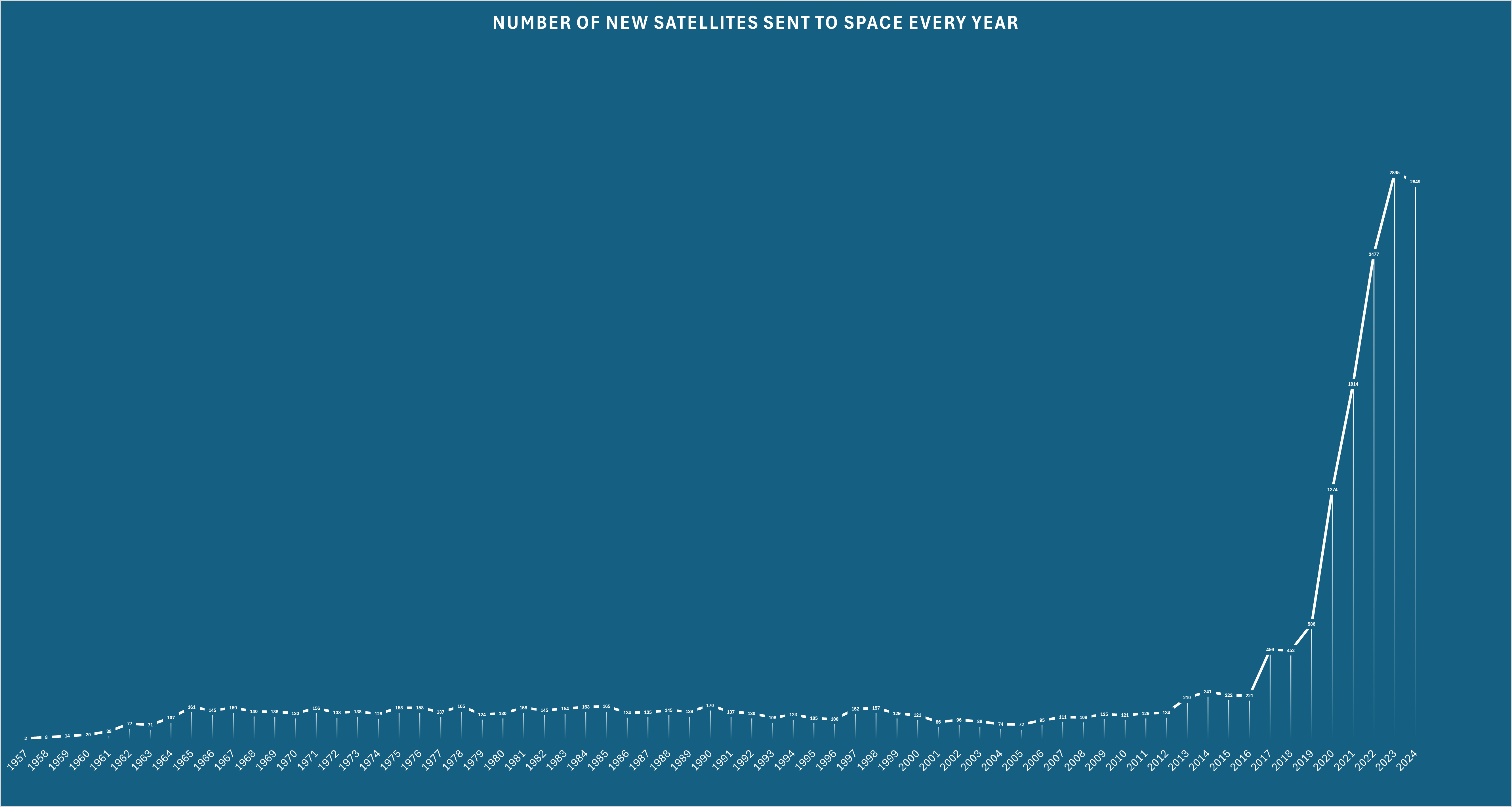Yesterday, April 28, was a big day in space launches, with not one but three different megaconstellations receiving new satellites. Eighty-seven new satellites were launched into orbit, which places the day among the top 20 busiest for putting objects into orbit – a list that includes multiple times where a rocket broke apart in space, adding hundreds of new fragments to the growing space junk problem.
The satellites launched yesterday were sent by China and private American companies SpaceX, owned by billionaire Elon Musk, and Amazon, owned by billionaire Jeff Bezos. China launched 10 satellites as part of its Xingwang satellite internet network. This is not the only Chinese megaconstellation plan; there is also Qianfan, which hopes to place 15,000 satellites by the project’s end.
SpaceX launched 50 Starlink satellites in total, in two launches; the first one with 23 on board and a second one with 27. A third Starlink launch with 23 satellites happened today, April 29. Starlink plans to deploy at least 12,000 satellites, with the possibility of reaching 34,000.
Amazon’s Project Kuiper also saw the launch of a substantial number of satellites, with 27 taking off yesterday. The goal for that megaconstellation is to have 3,236 in low-Earth orbit.
So what are the pros, cons, and the not-so-clear-cut issues with megaconstellations?
The pros: Internet access everywhere
Internet access has become, for better or for worse, fundamental to most people on the planet. It is so important to live and participate in society, which is considered by many an essential utility, making the ability to get on the net a human right.
This access is very unequal, and so satellite internet could be a great equalizer, bringing broadband speed to places where there is no or limited high-speed infrastructure, such as optical fiber. It can also be used by scientific missions, even possible automatic surveys that could collect data from the deep ocean and then transmit it to the researchers without being on the vessels.
This, at least, is the general spiel of the power of satellite internet, but for most people, the cost of this technology is well beyond what’s affordable, especially in rural areas on a monthly basis.
The cons: Light pollution and a looming crisis
According to the United Nations Office for Outer Space Affairs (UNOOSA), as of today, there are 14,926 objects in orbit. Slightly less than half, 7,234 to be exact, are Starlink satellites present in low-Earth orbit, making them by far the largest group of satellites in space.

Over the last decade, the number of satellites in space has increased massively.
Image Credit: IFLScience
The number of satellites in orbit has massively increased in the last several years. Just consider that in the first four months of 2025, there have been more satellites than in the whole of 2018. A major concern is the brightness that these objects bring with them. Many of them reflect sunlight as they orbit the Earth. This negatively affects advanced astronomy but also brings light pollution to places that never had it before.
But the other concern is the increase in space junk and the risk that some regions of space around Earth might become impossible to navigate. There is a possible crisis known as Kessler Syndrome. Space junk collides with a satellite that breaks apart, creating more space junk and causing more collisions and so on, growing exponentially. The more objects there are in space, the higher the risk of this becoming a reality. (There are some proposed countermeasures, though.)
There are ways to minimize the effects of megaconstellations, and some are being taken on board, but non-binding suggestions are playing catch-up with the deployment.
The complex: He who controls the internet controls the universe
The rules and regulations that control space are collected in the 1967 Outer Space Treaty, and they are not fit for purpose in 2025. Hence why private companies can send thousands of satellites to space. If they decide that bright satellites and light pollution across a common heritage like the night sky are a small price to pay, since they are not the ones paying it, they can do that.
With that consideration in mind, even the potential for internet everywhere leads us to a complicated discussion on the wielding of power, such as access to the World Wide Web. In 2022, the Iranian government blocked internet access to suppress the spread of anti-government protests. Elon Musk announced that it would give Iranian citizens access to Starlink.
Access to Starlink was also given to Ukraine, fighting the Russian invasion, through a contract with the United States Department of Defense. But it’s been suggested that Musk, involved in the Trump administration attacks on Science, could cut off Ukraine from the internet service.
That has not happened, but it has shown the power that billionaires have over space, access to it, who benefits from it, and who doesn’t. Space directly and indirectly affects our daily life, from weather forecasts to GPS and more. What happens up there doesn’t stay there.
Source Link: 87 Satellites Sent To Space In The Last 24 Hours – Space Is Becoming Ever More Crowded